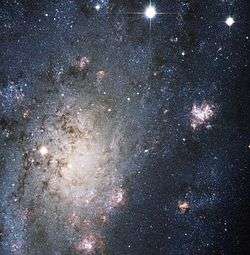NGC 2403
| NGC 2403 | |
|---|---|
|
| |
| Observation data (J2000 epoch) | |
| Constellation | Camelopardalis |
| Right ascension | 07h 36m 51.4s[1] |
| Declination | +65° 36′ 09″[1] |
| Redshift | 131 ± 3 km/s[1] |
| Distance | 8 Mly (2.5 Mpc)[2] |
| Apparent magnitude (V) | 8.9[1] |
| Characteristics | |
| Type | SAB(s)cd[1] |
| Apparent size (V) | 21′.9 × 12′.3[1] |
| Other designations | |
| UGC 3918,[1] PGC 21396,[1] Caldwell 7 | |
Coordinates: ![]() 07h 36m 51.4s, +65° 36′ 09″
07h 36m 51.4s, +65° 36′ 09″
NGC 2403 (also Caldwell 7) is an intermediate spiral galaxy in the constellation Camelopardalis. NGC 2403 is an outlying member of the M81 Group,[2] and is approximately 8 million light-years distant. It bears a striking similarity to M33, being about 50,000 light years in diameter and containing numerous star-forming H II regions.[3] The northern spiral arm connects it to a Star forming region NGC 2404.[2] NGC 2403 can be observed using 10×50 binoculars.[2]
Supernovae
As of late 2004, there had been two reported supernovae in the galaxy: SN 1954J, which attained a magnitude of 16 at its brightest, and SN 2004dj.

History
The galaxy was discovered by William Herschel in 1788. Allan Sandage detected Cepheid variables in NGC 2403 using the Hale telescope, giving it the distinction of being the first galaxy beyond the Local Group within which a Cepheid was discovered.[2] He derived a distance of a mere 8 thousand light years.[2] Today, it is thought to be a thousand times further away at about 8 million light years (2.5 Mpc).
See also
References
- 1 2 3 4 5 6 7 8 "NASA/IPAC Extragalactic Database". Results for NGC 2403. Retrieved 2006-11-21.
- 1 2 3 4 5 6 Kepple, George Robert; Glen W. Sanner (1998). The Night Sky Observer's Guide. 1. Willmann-Bell, Inc. p. 73. ISBN 0-943396-58-1.
- ↑ Ho, Luis C.; Filippenko, Alexei V.; Sargent, Wallace L. W. (October 1997). "A Search for "Dwarf" Seyfert Nuclei. III. Spectroscopic Parameters and Properties of the Host Galaxies". Astrophysical Journal Supplement. 112: 315–390. Bibcode:1997ApJS..112..315H. arXiv:astro-ph/9704107
 . doi:10.1086/313041.
. doi:10.1086/313041.
External links
| Wikimedia Commons has media related to NGC 2403. |
- Spiral Galaxy NGC 2403 at the astro-photography site of Mr. Takayuki Yoshida
- NGC 2403 at ESA/Hubble
- NGC 2403 on WikiSky: DSS2, SDSS, GALEX, IRAS, Hydrogen α, X-Ray, Astrophoto, Sky Map, Articles and images
- NASA Astronomy Picture of the Day: NGC 2403 (19 February 2016)
